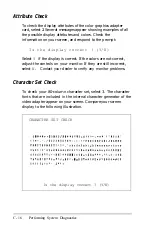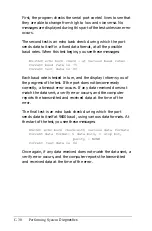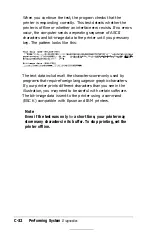
First, the program checks the serial port control lines to see that
they are able to change from high to low and vice versa. No
messages are displayed during this part of the test unless an error
occurs.
The second test is an echo back check during which the port
sends data to itself in a fixed data format, at all the possible
baud rates. When this test begins, you see these messages:
RS-232C echo back check - at various baud rates
Current baud rate is 75
Current test data is 00
Each baud rate is tested in turn, and the display informs you of
the progress of the test. If the port does not become ready
correctly, a timeout error occurs. If any data received does not
match the data sent, a verify error occurs, and the computer
reports the transmitted and received data at the time of the
error.
The final test is an echo back check during which the port
sends data to itself at 9600 baud, using various data formats. At
the start of the test, you see these messages:
RS232C echo back check-with various data formats
Current data format: 5 data bits, 1 stop bit,
parity - NONE
Current test data is 00
Once again, if any data received does not match the data sent, a
verify error occurs, and the computer reports the transmitted
and received data at the time of the error.
C-30
Performing System
Diagnostics
Summary of Contents for Equity 386SX PLUS
Page 1: ...m u cl3 0 z E 5 J I 1 al y 8 c 7 5 w ii u l X ...
Page 4: ...EPSON E Q U I T Y 3 8 6 S X User s Guide Y19299100100 ...
Page 20: ...6 Introduction ...
Page 38: ...1 18 Setting Up Your System ...
Page 69: ......
Page 70: ...2 32 Running the Setup Program ...
Page 96: ... 7 R _ ri h 14 3 26 Using the Equity 386SX ...
Page 168: ...5 26 dling Options ...
Page 192: ...B 4 Power on Diagnostics ...
Page 232: ...C 40 Performing System Diagnostics ...
Page 246: ... D 14 Physically Formatting a Hard Disk ...
Page 250: ...E 4 Hard Disk Drive Types ...
Page 282: ...8 I n d e x ...
Page 284: ......
















































